The Project Gutenberg eBook of Birds, Illustrated by Color Photography, Vol. 1, No. 6
most other parts of the world at no cost and with almost no restrictions
whatsoever. You may copy it, give it away or re-use it under the terms
of the Project Gutenberg License included with this ebook or online
at www.gutenberg.org. If you are not located in the United States,
you will have to check the laws of the country where you are located
before using this eBook.
Title: Birds, Illustrated by Color Photography, Vol. 1, No. 6
Author: Various
Release date: December 13, 2009 [eBook #30666]
Most recently updated: January 5, 2021
Language: English
Credits: Produced by Chris Curnow, Joseph Cooper, Anne Storer, and
the Online Distributed Proofreading Team at
https://www.pgdp.net
*** START OF THE PROJECT GUTENBERG EBOOK BIRDS, ILLUSTRATED BY COLOR PHOTOGRAPHY, VOL. 1, NO. 6 ***
Transcriber’s Notes:
1) Cover added.
2) A couple of unusual spellings in the “ads”
have been left as printed.
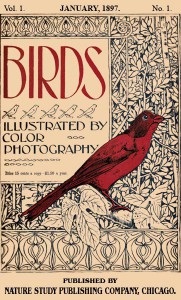




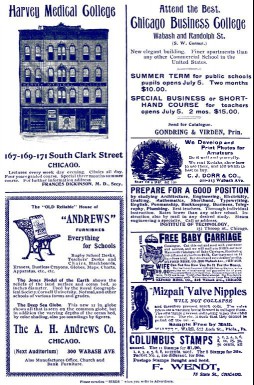
BIRDS
ILLUSTRATED BY COLOR PHOTOGRAPHY
A MONTHLY SERIAL
DESIGNED TO PROMOTE
KNOWLEDGE OF BIRD-LIFE
“With cheerful hop from perch to spray,
They sport along the meads;
In social bliss together stray,
Where love or fancy leads.
Through spring’s gay scenes each happy pair
Their fluttering joys pursue;
Its various charms and produce share,
Forever kind and true.”
CHICAGO, U. S. A.
Nature Study Publishing Company, Publishers
1896
PREFACE.
T has become a universal custom to obtain and preserve the likenesses
of one’s friends. Photographs are the most popular form of these likenesses,
as they give the true exterior outlines and appearance, (except
coloring) of the subjects. But how much more popular and useful does
photography become, when it can be used as a means of securing plates from
which to print photographs in a regular printing press, and, what is more
astonishing and delightful, to produce the real colors of nature as shown in
the subject, no matter how brilliant or varied.
We quote from the December number of the Ladies’ Home Journal:
“An excellent suggestion was recently made by the Department of Agriculture
at Washington that the public schools of the country shall have a new holiday,
to be known as Bird Day. Three cities have already adopted the suggestion,
and it is likely that others will quickly follow. Of course, Bird Day will differ
from its successful predecessor, Arbor Day. We can plant trees but not birds.
It is suggested that Bird Day take the form of bird exhibitions, of bird exercises,
of bird studies—any form of entertainment, in fact, which will bring
children closer to their little brethren of the air, and in more intelligent
sympathy with their life and ways. There is a wonderful story in bird life, and
but few of our children know it. Few of our elders do, for that matter. A
whole day of a year can well and profitably be given over to the birds. Than
such study, nothing can be more interesting. The cultivation of an intimate
acquaintanceship with our feathered friends is a source of genuine pleasure.
We are under greater obligations to the birds than we dream of. Without them
the world would be more barren than we imagine. Consequently, we have
some duties which we owe them. What these duties are only a few of us
know or have ever taken the trouble to find out. Our children should not be
allowed to grow to maturity without this knowledge. The more they know of
the birds the better men and women they will be. We can hardly encourage
such studies too much.”
Of all animated nature, birds are the most beautiful in coloring, most
graceful in form and action, swiftest in motion and most perfect emblems of
freedom.
They are withal, very intelligent and have many remarkable traits,
so that their habits and characteristics make a delightful study for all lovers of
nature. In view of the facts, we feel that we are doing a useful work for the
young, and one that will be appreciated by progressive parents, in placing
within the easy possession of children in the homes these beautiful photographs
of birds.
The text is prepared with the view of giving the children as clear an idea
as possible, of haunts, habits, characteristics and such other information as will
lead them to love the birds and delight in their study and acquaintance.
NATURE STUDY PUBLISHING
[Pg 187]
BIRDS.
Illustrated by COLOR PHOTOGRAPHY.
BIRD SONG.
“I cannot love the man who doth not love,
As men love light, the song of happy birds.”
T is indeed fitting that the
great poets have ever been the
best interpreters of the songs of
birds. In many of the plays of
Shakespeare, especially where the
scene is laid in the primeval forest, his
most delicious bits of fancy are
inspired by the flitting throng.
Wordsworth and Tennyson, and many
of the minor English poets, are pervaded
with bird notes, and Shelley’s masterpiece,
The Skylark, will long survive
his greater and more ambitious poems.
Our own poet, Cranch, has left one
immortal stanza, and Bryant, and
Longfellow, and Lowell, and Whittier,
and Emerson have written enough
of poetic melody, the direct inspiration
of the feathered inhabitants of the
woods, to fill a good-sized volume. In
prose, no one has said finer things than
Thoreau, who probed nature with a
deeper ken than any of his contemporaries.
He is to be read, and read,
and read.
But just what meaning should be
attached to a bird’s notes—some of
which are “the least disagreeable of
noises”—will probably never be discovered.
They do seem to express
almost every feeling of which the
human heart is capable. We wonder
if the Mocking Bird understands what
all these notes mean. He is so fine an
imitator that it is hard to believe he is
not doing more than mimicking the
notes of other birds, but rather that
he really does mock them with a sort
of defiant sarcasm. He banters them
less, perhaps, than the Cat Bird, but
one would naturally expect all other
birds to fly at him with vengeful
purpose. But perhaps the birds are
not so sensitive as their human
brothers, who do not always look upon
imitation as the highest flattery.
A gentleman who kept a note-book,
describes one of the matinee performances
of the Mocker, which he attended
by creeping under a tent curtain. He
sat at the foot of a tree on the top of
which the bird was perched unconscious
of his presence. The Mocker
gave one of the notes of the Guinea-hen,
a fine imitation of the Cardinal,
or Red Bird, an exact reproduction of
the note of the Phoebe, and some of the
difficult notes of the Yellow-breasted
Chat. “Now I hear a young chicken
peeping. Now the Carolina Wren sings,
‘cheerily, cheerily, cheerily.’ Now a
small bird is shrilling with a fine insect
tone. A Flicker, a Wood-pewee, and a
Phoebe follow in quick succession.
Then a Tufted Titmouse squeals.
To display his versatility, he gives a
dull performance which couples the
‘go-back’ of the Guinea fowl with the
[Pg 188]
plaint of the Wood-pewee, two widely
diverse vocal sounds. With all the
performance there is such perfect self-reliance
and consciousness of superior
ability that one feels that the singer
has but to choose what bird he will
imitate next.”
Nor does the plaintive, melancholy
note of the Robin, that “pious” bird,
altogether express his character. He
has so many lovely traits, according to
his biographers, that we accept him
unhesitatingly as a truly good bird.
Didn’t he once upon a time tenderly
cover with leaves certain poor little
wanderers? Isn’t he called “The Bird
of the Morning?” And evening as
well, for you can hear his sad voice
long after the sun has himself retired.
The poet Coleridge claims the credit
of first using the Owl’s cry in poetry,
and his musical note Tu-whit, tu-who!
has made him a favorite with the
poets. Tennyson has fancifully
played upon it in his little “Songs to
the Owl,” the last stanza of which
runs:
“I would mock thy chant anew;
But I cannot mimic it,
Not a whit of thy tuhoo,
Thee to woo to thy tuwhit,
Thee to woo to thy tuwhit.
With a lengthen’d loud halloo,
Tuwhoo, tuwhit, tuwhit, tuhoo-o-o.”
But Coleridge was not correct in his
claim to precedence in the use of the
Owl’s cry, for Shakespeare preceded
him, and Tennyson’s “First Song to
the Owl” is modeled after that at the
end of “Love’s Labor Lost:”
“When roasted crabs hiss in the bowl,
Then nightly sings the staring Owl,
Tu-who;
Tu-whit, tu-who, a merry note.”
In references to birds, Tennyson is
the most felicitous of all poets and the
exquisite swallow-song in “The
Princess” is especially recommended
to the reader’s perusal.
Birds undoubtedly sing for the same
reasons that inspire to utterance all
the animated creatures in the universe.
Insects sing and bees, crickets, locusts,
and mosquitos. Frogs sing, and mice,
monkeys, and woodchucks. We have
recently heard even an English
Sparrow do something better than
chipper; some very pretty notes
escaped him, perchance, because his
heart was overflowing with love-thoughts,
and he was very merry, knowing
that his affection was reciprocated.
The elevated railway stations, about
whose eaves the ugly, hastily built
nests protrude everywhere, furnish
ample explanation of his reasons for
singing.
Birds are more musical at certain
times of the day as well as at certain
seasons of the year. During the hour
between dawn and sunrise occurs the
grand concert of the feathered folk.
There are no concerts during the
day—only individual songs. After
sunset there seems to be an effort to
renew the chorus, but it cannot be
compared to the morning concert
when they are practically undisturbed
by man.
Birds sing because they are happy.
Bradford Torrey has given with much
felicity his opinion on the subject, as
follows:
“I recall a Cardinal Grosbeak, whom
I heard several years ago, on the bank
of the Potomac river. An old soldier
had taken me to visit the Great Falls,
and as we were clambering over the
rocks this Grosbeak began to sing;
and soon, without any hint from me,
and without knowing who the invisible
musician was, my companion remarked
upon the uncommon beauty of the
song. The Cardinal is always a great
singer, having a voice which, as
European writers say, is almost equal
to the Nightingale’s; but in this case
the more stirring, martial quality of
the strain had given place to an
exquisite mellowness, as if it were,
what I have no doubt it was,
A Song of Love.”
—C. C. Marble.
[to be continued.]
[Pg 189]

yellow-throated vireo.
From col. F. M. Woodruff.
[Pg 191]
THE YELLOW-THROATED VIREO.

HE popular name of this species
of an attractive family is
Yellow Throated Greenlet,
and our young readers will
find much pleasure in watching its
pretty movements and listening to its
really delightful song whenever they
visit the places where it loves to spend
the happy hours of summer. In some
respects it is the most remarkable of
all the species of the family found in
the United States. “The Birds of
Illinois,” a book that may be profitably
studied by the young naturalist, states
that it is decidedly the finest singer,
has the loudest notes of admonition
and reproof, and is the handsomest in
plumage, and hence the more attractive
to the student.
A recognized observer says he has
found it only in the woods, and mostly
in the luxuriant forests of the bottom
lands. The writer’s experience accords
with that of Audubon and Wilson,
the best authorities in their day, but
the habits of birds vary greatly with
locality, and in other parts of the
country, notably in New England, it
is very familiar, delighting in the
companionship of man. It breeds in
eastern North America, and winters in
Florida, Cuba and Central America.
The Vireo makes a very deep nest,
suspended by its upper edge, between
the forks of a horizontal branch. The
eggs are white, generally with a few
reddish brown blotches. All authorities
agree as to the great beauty of the
nest, though they differ as to its exact
location. It is a woodland bird, loving
tall trees and running water,
“haunting the same places as the
Solitary Vireo.” During migration
the Yellow-throat is seen in orchards
and in the trees along side-walks and
lawns, mingling his golden colors with
the rich green of June leaves.
The Vireos, or Greenlets, are like
the Warblers in appearance and habits.
We have no birds, says Torrey, that
are more unsparing of their music;
they sing from morning till night,
and—some of them, at least—continue
theirs till the very end of the
season. The song of the Yellow-throat
is rather too monotonous and
persistent. It is hard sometimes not
to get out of patience with its ceasless
and noisy iteration of its simple tune;
especially if you are doing your utmost
to catch the notes of some rarer and
more refined songster. This is true
also of some other birds, whose occasional
silence would add much to their
attractiveness.
[Pg 192]
THE MOCKING BIRD.
Some bright morning this
month, you may hear a Robin’s
song from a large tree near by.
A Red Bird answers him and
then the Oriole chimes in. I can
see you looking around to find
the birds that sing so sweetly.
All this time a gay bird sits
among the green leaves and
laughs at you as you try to find
three birds when only one is
there.
It is the Mocking Bird or
Mocker, and it is he who has
been fooling you with his song.
Nature has given him lots of
music and gifted him with the
power of imitating the songs of
other birds and sounds of other
animals.
He is certainly the sweetest of
our song birds. The English
Nightingale alone is his rival.
I think, however, if our Mocker
could hear the Nightingale’s
song, he could learn it.
The Mocking Bird is another
of our Thrushes. By this time
you have surely made up your
minds that the Thrushes are
sweet singers.
The Mocker seems to take
delight in fooling people. One
gentleman while sitting on his
porch heard what he thought to
be a young bird in distress. He
went in the direction of the
sound and soon heard the same
cry behind him. He turned and
went back toward the porch,
when he heard it in another
direction. Soon he found out
that Mr. Mocking Bird had been
fooling him, and was flying
about from shrub to shrub
making that sound.
His nest is carelessly made
of almost anything he can find.
The small, bluish-green eggs
are much like the Catbird’s eggs.
Little Mocking Birds look
very much like the young of
other Thrushes, and do not
become Mockers like their parents,
until they are full grown.
Which one of the other
Thrushes that you have seen in
Birds does the Mocking Bird
resemble?
He is the only Thrush that
sings while on the wing. All
of the others sing only while
perching.
[Pg 193]
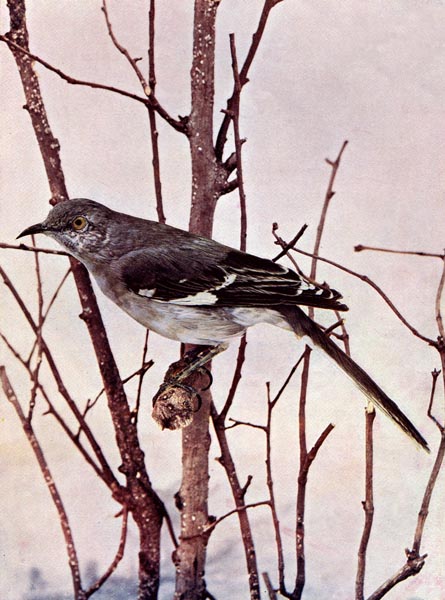
american mocking bird.
From col. F. M. Woodruff.
[Pg 194]
JUNE.
Frank-hearted hostess of the field and wood,
Gipsy, whose roof is every spreading tree,
June is the pearl of our New England year,
Still a surprisal, though expected long,
Her coming startles. Long she lies in wait,
Makes many a feint, peeps forth, draws coyly back,
Then, from some southern ambush in the sky,
With one great gush of blossoms storms the world.
A week ago the Sparrow was divine;
The Bluebird, shifting his light load of song
From post to post along the cheerless fence,
Was as a rhymer ere the poet came;
But now, O rapture! sunshine winged and voiced,
Pipe blown through by the warm, wild breath of the West,
Shepherding his soft droves of fleecy cloud,
Gladness of woods, skies, waters, all in one,
The Bobolink has come, and, like the soul
Of the sweet season vocal in a bird,
Gurgles in ecstasy we know not what
Save June! Dear June! Now God be praised for June.
—Lowell.
[Pg 196]
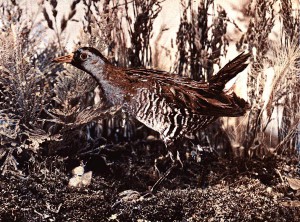
black-crowned night heron.
From col. Chi. Acad. Sciences.
[Pg 197]
THE BLACK-CROWNED NIGHT HERON.

HAT a beautiful creature
this is! A mounted specimen
requires, like the
Snowy Owl, the greatest
care and a dust tight glass case to preserve
its beauty. Dr. Coues’ account
of it should be read by those who are
interested in the science of ornithology.
It is a common bird in the United
States and British Provinces, being
migratory and resident in the south.
Heronries, sometimes of vast extent, to
which they return year after year, are
their breeding places. Each nest contains
three or four eggs of a pale, sea-green
color. Observe the peculiar
plumes, sometimes two, in this case
three, which spring from the back of
the head. These usually lie close
together in one bundle, but are often
blown apart by the wind in the form
of streamers. This Heron derives its
name from its habits, as it is usually
seen flying at night, or in the early
evening, when it utters a sonorous cry
of quaw or quawk. It is often called
Quawk or Qua-Bird.
On the return of the Black-Crowned
Night Heron in April, he promptly
takes possession of his former home,
which is likely to be the most solitary
and deeply shaded part of a cedar
swamp. Groves of swamp oak in
retired and water covered places, are
also sometimes chosen, and the males
often select tall trees on the bank of
the river to roost upon during the day.
About the beginning of twilight they
direct their flight toward the marshes,
uttering in a hoarse and hollow tone,
the sound qua. At this hour all the
nurseries in the swamps are emptied
of their occupants, who disperse about
the marshes along the ditches and
river shore in search of food. Some
of these nesting places have been
occupied every spring and summer for
many years by nearly a hundred pair
of Herons. In places where the cedars
have been cut down and removed the
Herons merely move to another part
of the swamp, not seeming greatly disturbed
thereby; but when attacked and
plundered they have been known to
remove from an ancient home in a
body to some unknown place.
The Heron’s nest is plain enough,
being built of sticks. On entering
the swamp in the neighborhood of one
of the heronries the noise of the old
and young birds equals that made by
a band of Indians in conflict. The
instant an intruder is discovered, the
entire flock silently rises in the air
and removes to the tops of the trees in
another part of the woods, while sentries
of eight or ten birds make occasional
circuits of inspection.
The young Herons climb to the tops
of the highest trees, but do not attempt
to fly. While it is probable these
birds do not see well by day, they
possess an exquisite facility of hearing,
which renders it almost impossible
to approach their nesting places
without discovery. Hawks hover over
the nests, making an occasional sweep
among the young, and the Bald Eagle
has been seen to cast a hungry eye
upon them.
The male and female can hardly be
distinguished. Both have the plumes,
but there is a slight difference in size.
The food of the Night Heron, or
Qua-Bird, is chiefly fish, and his two
interesting traits are tireless watchfulness
and great appetite. He digests
his food with such rapidity that however
much he may eat, he is always
ready to eat again; hence he is little
benefited by what he does eat, and is
ever in appearance in the same half-starved
state, whether food is abundant
or scarce.
[Pg 198]
THE RING-BILLED GULL.

HE Ring-billed Gull is a common
species throughout eastern
North America, breeding
throughout the northern tier
of the United States, whose northern
border is the limit of its summer
home. As a rule in winter it is found
in Illinois and south to the Gulf of
Mexico. It is an exceedingly voracious
bird, continually skimming over
the surface of the water in search of
its finny prey, and often following
shoals of fish to great distances. The
birds congregate in large numbers at
their breeding places, which are rocky
islands or headlands in the ocean.
Most of the families of Gulls are somewhat
migratory, visiting northern
regions in summer to rear their young.
The following lines give with remarkable
fidelity the wing habits and
movements of this tireless bird:
“On nimble wing the gull
Sweeps booming by, intent to cull
Voracious, from the billows’ breast,
Marked far away, his destined feast.
Behold him now, deep plunging, dip
His sunny pinion’s sable tip
In the green wave; now highly skim
With wheeling flight the water’s brim;
Wave in blue sky his silver sail
Aloft, and frolic with the gale,
Or sink again his breast to lave,
And float upon the foaming wave.
Oft o’er his form your eyes may roam,
Nor know him from the feathery foam,
Nor ’mid the rolling waves, your ear
On yelling blast his clamor hear.”
This Gull lives principally on fish,
but also greedily devours insects. He
also picks up small animals or animal
substances with which he meets, and,
like the vulture, devours them even in a
putrid condition. He walks well and
quickly, swims bouyantly, lying in the
water like an air bubble, and dives with
facility, but to no great depth.
As the breeding time approaches
the Gulls begin to assemble in flocks,
uniting to form a numerous host.
Even upon our own shores their nesting
places are often occupied by many
hundred pairs, whilst further north
they congregate in countless multitudes.
They literally cover the rocks
on which their nests are placed, the
brooding parents pressing against each
other.
Wilson says that the Gull, when
riding bouyantly upon the waves and
weaving a sportive dance, is employed
by the poets as an emblem of purity,
or as an accessory to the horrors of a
storm, by his shrieks and wild piercing
cries. In his habits he is the vulture
of the ocean, while in grace of motion
and beauty of plumage he is one of
the most attractive of the splendid
denizens of the ocean and lakes.
The Ring-billed Gull’s nest varies
with localities. Where there is grass
and sea weed, these are carefully
heaped together, but where these fail
the nest is of scanty material. Two
to four large oval eggs of brownish
green or greenish brown, spotted with
grey and brown, are hatched in three
or four weeks, the young appearing in
a thick covering of speckled down.
If born on the ledge of a high rock,
the chicks remain there until their
wings enable them to leave it, but if
they come from the shell on the sand
of the beach they trot about like little
chickens. During the first few days
they are fed with half-digested food
from the parents’ crops, and then with
freshly caught fish.
The Gull rarely flies alone, though
occasionally one is seen far away from
the water soaring in majestic solitude
above the tall buildings of the city.
[Pg 199]
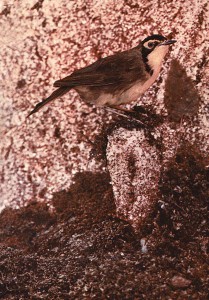
ring-billed gull.
From col. Chi. Acad. Sciences.
[Pg 201]
THE MOCKING BIRD.

HE Mocking Bird is regarded as
the chief of songsters, for in
addition to his remarkable
powers of imitation, he is
without a rival in variety of notes.
The Brown Thrasher is thought by
many to have a sweeter song, and one
equally vigorous, but there is a bold
brilliancy in the performance of the
Mocker that is peculiarly his own, and
which has made him par excellence
the forest extemporizer of vocal melody.
About this of course there will
always be a difference of opinion, as
in the case of the human melodists.
So well known are the habits and
characteristics of the Mocking Bird
that nearly all that could be written
about him would be but a repetition
of what has been previously said.
In Illinois, as in many other states,
its distribution is very irregular, its
absence from some localities which
seem in every way suited being very
difficult to account for. Thus, according
to “Birds of Illinois,” while one or
two pairs breed in the outskirts of
Mount Carmel nearly every season, it
is nowhere in that vicinity a common
bird. A few miles further north, however,
it has been found almost abundant.
On one occasion, during a three
mile drive from town, six males were
seen and heard singing along the roadside.
Mr. H. K. Coale says that he
saw a mocking bird in Stark county,
Indiana, sixty miles southeast of Chicago,
January 1, 1884; that Mr.
Green Smith had met with it at Kensington
Station, Illinois, and that several
have been observed in the parks
and door-yards of Chicago. In the
extreme southern portion of the state
the species is abundant, and is resident
through the year.
The Mocking Bird does not properly
belong among the birds of the middle
or eastern states, but as there are
many records of its nesting in these
latitudes it is thought to be safe to
include it. Mrs. Osgood Wright states
that individuals have often been seen
in the city parks of the east, one having
lived in Central Park, New York
city, late into the winter, throughout
a cold and extreme season. They
have reared their young as far north
as Arlington, near Boston, where they
are noted, however, as rare summer
residents. Dr. J. A. Allen, editor of The
Auk, notes that they occasionally nest
in the Connecticut Valley.
The Mocking Bird has a habit of
singing and fluttering in the middle of
the night, and in different individuals
the song varies, as is noted of many
birds, particularly canaries. The song
is a natural love song, a rich dreamy
melody. The mocking song is imitative
of the notes of all the birds of
field, forest, and garden, broken into
fragments.
The Mocker’s nest is loosely made
of leaves and grass, rags, feathers, etc.,
plain and comfortable. It is never far
from the ground. The eggs are four
to six, bluish green, spattered with
shades of brown.
Wilson’s description of the Mocking
Bird’s song will probably never be
surpassed: “With expanded wings and
tail glistening with white, and the
bouyant gayety of his action arresting
the eye, as his song does most irresistably
the ear, he sweeps around with
enthusiastic ecstasy, and mounts and
descends as his song swells or dies
away. And he often deceives the
sportsman, and sends him in search of
birds that are not perhaps within miles
of him, but whose notes he exactly
imitates.”
Very useful is he, eating large spiders
and grasshoppers, and the destructive
cottonworm.
[Pg 202]
THE LOGGERHEAD SHRIKE.

RAMBLER in the fields and
woodlands during early
spring or the latter part
of autumn is often surprised
at finding insects,
grasshoppers, dragon flies, beetles of
all kinds, and even larger game, mice,
and small birds, impaled on twigs and
thorns. This is apparently cruel
sport, he observes, if he is unacquainted
with the Butcher Bird and his
habits, and he at once attributes it to
the wanton sport of idle children who
have not been led to say,
With hearts to love, with eyes to see,
With ears to hear their minstrelsy;
Through us no harm, by deed or word,
Shall ever come to any bird.
If he will look about him, however,
the real author of this mischief will
soon be detected as he appears with
other unfortunate little creatures,
which he requires to sustain his own
life and that of his nestlings. The
offender he finds to be the Shrike of
the northern United States, most
properly named the Butcher Bird.
Like all tyrants he is fierce and brave
only in the presence of creatures
weaker than himself, and cowers and
screams with terror if he sees a falcon.
And yet, despite this cruel proceeding,
which is an implanted instinct
like that of the dog which buries
bones he never seeks again, there are
few more useful birds than the Shrike.
In the summer he lives on insects,
ninety-eight per cent. of his food for
July and August consisting of insects,
mainly grasshoppers; and in winter,
when insects are scarce, mice form a
very large proportion of his food.
The Butcher Bird has a very agreeable
song, which is soft and musical,
and he often shows cleverness as a
mocker of other birds. He has been
taught to whistle parts of tunes, and
is as readily tamed as any of our
domestic songsters.
The nest is usually found on the
outer limbs of trees, often from fifteen
to thirty feet from the ground. It is
made of long strips of the inner bark
of bass-wood, strengthened on the
sides with a few dry twigs, stems, and
roots, and lined with fine grasses. The
eggs are often six in number, of a
yellowish or clayey-white, blotched
and marbled with dashes of purple,
light brown, and purplish gray.
Pretty eggs to study.
Readers of Birds who are interested
in eggs do not need to disturb the
mothers on their nests in order to see
and study them. In all the great
museums specimens of the eggs of
nearly all birds are displayed in cases,
and accurately colored plates have
been made and published by the
Smithsonian Institution and others.
The Chicago Academy of Sciences has
a fine collection of eggs. Many
persons imagine that these institutions
engage in cruel slaughter of birds in
order to collect eggs and nests. This,
of course, is not true, only the fewest
number being taken, and with the
exclusive object of placing before the
people, not for their amusement but
rather for their instruction, specimens
of birds and animals which shall serve
for their identification in forest and
field.
The Loggerhead Shrike and nest
shown in this number were taken under
the direction of Mr. F. M. Woodruff, at
Worth, Ill., about fourteen miles from
Chicago. The nest was in a corner of
an old hedge of Osage Orange, and
about eight feet from the ground. He
says in the Osprey that it took considerable
time and patience to build
up a platform of fence boards and old
boxes to enable the photographer to
do his work. The half-eaten body of
a young garter snake was found about
midway between the upper surface of
the nest and the limb above, where it
had been hung up for future use.
[Pg 203]
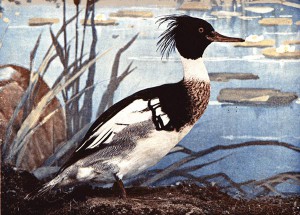
loggerhead shrike.
From col. Chi. Acad. Sciences.
[Pg 205]
THE BALTIMORE ORIOLE.

ALTIMORE Orioles are inhabitants
of the whole of
North America, from Canada
to Mexico. They
enter Louisiana as soon as
spring commences there. The name
of Baltimore Oriole has been given it,
because its colors of black and orange
are those of the family arms of Lord
Baltimore, to whom Maryland formerly
belonged. Tradition has it that
George Calvert, the first Baron Baltimore,
worn out and discouraged by
the various trials and rigours of temperature
experienced in his Newfoundland
colony in 1628, visited the Virginia
settlement. He explored the
waters of the Chesapeake, and found
the woods and shores teeming with
birds, among them great flocks of
Orioles, which so cheered him by their
beauty of song and splendor of plumage,
that he took them as good omens
and adopted their colors for his
own.
When the Orioles first arrive the
males are in the majority; they sit in
the spruces calling by the hour, with
lonely querulous notes. In a few days
however, the females appear, and then
the martial music begins, the birds’
golden trumpeting often turning to a
desperate clashing of cymbals when
two males engage in combat, for “the
Oriole has a temper to match his flaming
plumage and fights with a will.”
This Oriole is remarkably familiar,
and fearless of man, hanging its beautiful
nest upon the garden trees, and
even venturing into the street wherever
a green tree nourishes. The
materials of which its nest is made are
flax, various kinds of vegetable fibers,
wool, and hair, matted together so as
to resemble felt in consistency. A
number of long horse-hairs are passed
completely through the fibers, sewing
it firmly together with large and irregular,
but strong and judiciously placed
stitching. In one of these nests an
observer found that several of the hairs
used for this purpose measured two
feet in length. The nest is in the
form of a long purse, six or seven
inches in depth, three or four inches
in diameter; at the bottom is arranged
a heap of soft material in which the
eggs find a warm resting place. The
female seems to be the chief architect,
receiving a constant supply of materials
from her mate, occasionally rejecting
the fibers or hairs which he may
bring, and sending him off for another
load more to her taste.
Like human builders, the bird improves
in nest building by practice,
the best specimens of architecture
being the work of the oldest birds,
though some observers deny this.
The eggs are five in number, and
their general color is whitish-pink,
dotted at the larger end with purplish
spots, and covered at the smaller end
with a great number of fine intersecting
lines of the same hue.
In spring the Oriole’s food seems to
be almost entirely of an animal nature,
consisting of caterpillars, beetles, and
other insects, which it seldom pursues
on the wing, but seeks with great
activity among the leaves and branches.
It also eats ripe fruit. The males
of this elegant species of Oriole acquire
the full beauty of their plumage the
first winter after birth.
The Baltimore Oriole is one of the
most interesting features of country
landscape, his movements, as he runs
among the branches of trees, differing
from those of almost all other birds.
Watch him clinging by the feet to
reach an insect so far away as to
require the full extension of the neck,
body, and legs without letting go his
hold. He glides, as it were, along a
small twig, and at other times moves
sidewise for a few steps. His motions
are elegant and stately.
[Pg 206]
THE BALTIMORE ORIOLE.
About the middle of May,
when the leaves are all coming
out to see the bright sunshine,
you may sometimes see, among
the boughs, a bird of beautiful
black and orange plumage.
He looks like the Orchard
Oriole, whose picture you saw
in May “Birds.” It is the Baltimore
Oriole. He has other
names, such as “Golden Robin,”
“Fire Bird,” “Hang-nest.” I
could tell you how he came to
be called Baltimore Oriole, but
would rather you’d ask your
teacher about it. She can tell
you all about it, and an interesting
story it is, I assure you.
You see from the picture why
he is called “Hang-nest.”
Maybe you can tell why he
builds his nest that way.
The Orioles usually select for
their nest the longest and slenderest
twigs, way out on the
highest branches of a large tree.
They like the elm best. From
this they hang their bag-like
nest.
It must be interesting to watch
them build the nest, and it
requires lots of patience, too,
for it usually takes a week or
ten days to build it.
They fasten both ends of a
string to the twigs between
which the nest is to hang. After
fastening many strings like this,
so as to cross one another,
they weave in other strings
crosswise, and this makes a sort
of bag or pouch. Then they put
in the lining.
Of course, it swings and rocks
when the wind blows, and what
a nice cradle it must be for the
baby Orioles?
Orioles like to visit orchards
and eat the bugs, beetles and
caterpillars that injure the trees
and fruit.
There are few birds who do
more good in this way than
Orioles.
Sometimes they eat grapes
from the vines and peck at fruit
on the trees. It is usually because
they want a drink that
they do this.
One good man who had a
large orchard and vineyard
placed pans of water in different
places. Not only the
Orioles, but other birds, would
go to the pan for a drink, instead
of pecking at the fruit. Let us
think of this, and when we have
a chance, give the birds a drink
of water. They will repay us
with their sweetest songs.
[Pg 207]
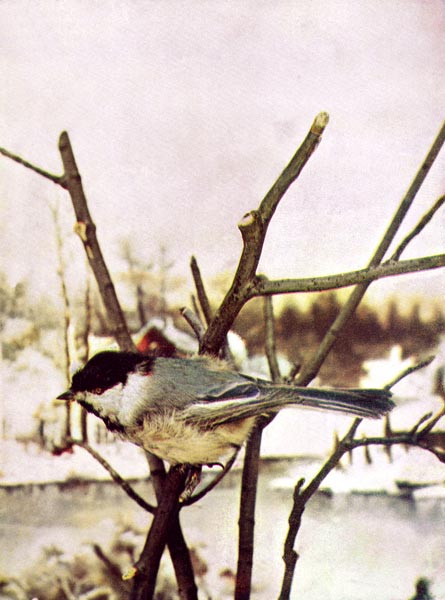
baltimore oriole.
From col. F. M. Woodruff.
[Pg 209]
THE SNOWY OWL.

EW of all the groups of birds
have such decided markings,
such characteristic distinctions,
as the Owl. There is a singular
resemblance between the face of an
Owl and that of a cat, which is the
more notable, as both of these creatures
have much the same habits, live
on the same prey, and are evidently
representatives of the same idea in
their different classes. The Owl, in
fact, is a winged cat, just as the cat is
a furred owl.
The Snowy Owl is one of the handsomest
of this group, not so much on
account of its size, which is considerable,
as by reason of the beautiful
white mantle which it wears, and the
large orange eyeballs that shine with
the lustre of a topaz set among the
snowy plumage.
It is a native of the north of Europe
and America, but is also found in the
more northern parts of England, being
seen, though rather a scarce bird, in
the Shetland and Orkney Islands,
where it builds its nest and rears its
young. One will be more likely to
find this owl near the shore, along the
line of salt marshes and woody stubble,
than further inland. The marshes do
not freeze so easily or deep as the iron
bound uplands, and field-mice are more
plentiful in them. It is so fleet of
wing that if its appetite is whetted, it
can follow and capture a Snow Bunting
or a Junco in its most rapid flight.
Like the Hawk Owl, it is a day-flying
bird, and is a terrible foe to the
smaller mammalia, and to various
birds. Mr. Yarrell in his “History of
the British Birds,” states that one
wounded on the Isle of Balta disgorged
a young rabbit whole, and that a young
Sandpiper, with its plumage entire,
was found in the stomach of another.
In proportion to its size the Snowy
Owl is a mighty hunter, having been
detected chasing the American hare,
and carrying off wounded Grouse
before the sportsman could secure his
prey. It is also a good fisherman,
posting itself on some convenient spot
overhanging the water, and securing
its finny prey with a lightning-like
grasp of the claw as it passes beneath
the white clad fisher. Sometimes it
will sail over the surface of a stream,
and snatch the fish as they rise for
food. It is also a great lover of lemmings,
and in the destruction of these
quadruped pests does infinite service
to the agriculturist.
The large round eyes of this owl are
very beautiful. Even by daylight
they are remarkable for their gem-like
sheen, but in the evening they are
even more attractive, glowing like
balls of living fire.
From sheer fatigue these birds often
seek a temporary resting place on
passing ships. A solitary owl, after a
long journey, settled on the rigging of
a ship one night. A sailor who was
ordered aloft, terrified by the two glowing
eyes that suddenly opened upon
his own, descended hurriedly to the
deck, declaring to the crew that he
had seen “Davy Jones a-sitting up
there on the main yard.”
[Pg 210]
THE SNOWY OWL.
What do you think of this bird
with his round, puffy head? You
of course know it is an Owl. I
want you to know him as the
Snowy Owl.
Don’t you think his face is
some like that of your cat?
This fellow is not full grown,
but only a child. If he were full
grown he would be pure white.
The dark color you see is only
the tips of the feathers. You
can’t see his beak very well for
the soft feathers almost cover it.
His large soft eyes look very
pretty out of the white feathers.
What color would you call them?
Most owls are quiet during the
day and very busy all night.
The Snowy Owl is not so quiet
day times. He flies about considerably
and gets most of his
food in daylight.
A hunter who was resting
under a tree, on the bank of a
river, tells this of him:
“A Snowy Owl was perched on
the branch of a dead tree that
had fallen into the river. He
sat there looking into the water
and blinking his large eyes.
Suddenly he reached out and
before I could see how he did it,
a fish was in his claws.”
This certainly shows that he
can see well in the day time. He
can see best, however, in the
twilight, in cloudy weather or
moonlight. That is the way
with your cat.
The wing feathers of the owl
are different from those of most
birds. They are as soft as down.
This is why you cannot hear him
when he flies. Owls while perching
are almost always found in
quiet places where they will not
be disturbed.
Did you ever hear the voice of
an owl in the night? If you
never have, you cannot imagine
how dreary it sounds. He surely
is “The Bird of the Night.”
[Pg 211]
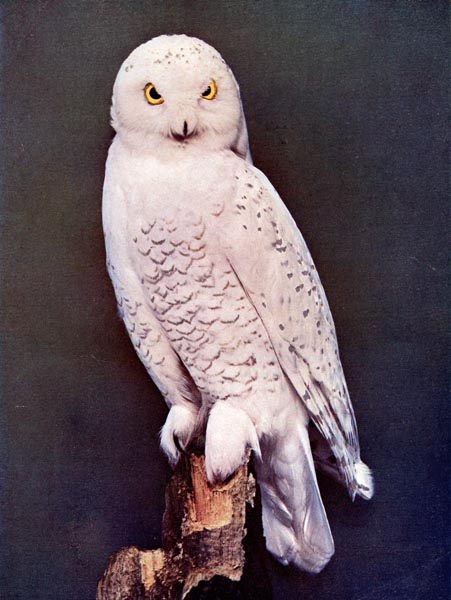
snowy owl.
From col. Chi. Acad. Sciences.
[Pg 213]
BIRDS AND FARMERS.
From the Forest and Stream.

HE advocates of protection for
our small birds present two
sets of reasons for preventing
their killing; the one sentimental,
and the other economic.
The sentimental reasons are the
ones most often urged; they are also
of a kind to appeal with especial force
to those whose responsibility for the
destruction of the birds is greatest.
The women and girls, for whose adornment
birds’ plumage is chiefly used,
think little and know less about the
services which birds perform for agriculture,
and indeed it may be doubted
whether the sight of a bunch of feathers
or a stuffed bird’s skin suggests to
them any thought of the life that
those feathers once represented. But
when the wearers are reminded that
there was such a life; that it was
cheery and beautiful, and that it was
cut short merely that their apparel
might be adorned, they are quick to
recognize that bird destruction involves
a wrong, and are ready to do their part
toward ending it by refusing to wear
plumage.
The small boy who pursues little
birds from the standpoint of the hunter
in quest of his game, feels only the ardor
of pursuit. His whole mind is concentrated
on that and the hunter’s
selfishness, the desire of possession, fills
his heart. Ignorance and thoughtlessness
destroy the birds.
Every one knows in a general way
that birds render most valuable service
to the farmer, but although these
services have long been recognized in
the laws standing on the statute books
of the various states, it is only within
a few years that any systematic
investigations have been undertaken to
determine just what such services are,
to measure them with some approach to
accuracy, to weigh in the case of each
species the good and the evil done, and
so to strike a balance in favor of the
bird or against it. The inquiries
carried on by the Agricultural Department
on a large scale and those made
by various local experiment stations
and by individual observers have given
results which are very striking and
which can no longer be ignored.
It is a difficult matter for any one to
balance the good things that he reads
and believes about any animal against
the bad things that he actually sees.
The man who witnesses the theft of
his cherries by robin or catbird, or the
killing of a quail by a marsh hawk,
feels that here he has ocular proof of
harm done by the birds, while as to
the insects or the field mice destroyed,
and the crops saved, he has only the
testimony of some unknown and distant
witness. It is only natural that
the observer should trust the evidence
of his senses, and yet his eyes tell him
only a small part of the truth, and that
small part a misleading one.
It is certain that without the services
of these feathered laborers, whose
work is unseen, though it lasts from
daylight till dark through every day
in the year, agriculture in this country
would come to an immediate standstill,
and if in the brief season of fruit
each one of these workers levies on
the farmer the tribute of a few berries,
the price is surely a small one to pay
for the great good done. Superficial
persons imagine that the birds are
here only during the summer, but this
is a great mistake. It is true that in
warm weather, when insect life is
most abundant, birds are also most
abundant. They wage an effective
and unceasing war against the adult
insects and their larvae, and check
their active depredations; but in
winter the birds carry on a campaign
which is hardly less important in its
results.
[Pg 214]
THE SCARLET TANAGER.

NE of the most brilliant and
striking of all American
birds is the Scarlet Tanager.
From its black wings resembling
pockets, it is frequently
called the “Pocket Bird.”
The French call it the “Cardinal.”
The female is plain olive-green, and
when seen together the pair present a
curious example of the prodigality
with which mother nature pours out
her favors of beauty in the adornment
of some of her creatures and seems
niggardly in her treatment of others.
Still it is only by contrast that we are
enabled to appreciate the quality of
beauty, which in this case is of the
rarest sort. In the January number
of Birds we presented the Red Rumped
Tanager, a Costa Rica bird, which,
however, is inferior in brilliancy to
the Scarlet, whose range extends from
eastern United States, north to southern
Canada, west to the great plains,
and south in winter to northern South
America. It inhabits woodlands and
swampy places. The nesting season
begins in the latter part of May, the
nest being built in low thick woods or
on the skirting of tangled thickets;
very often also, in an orchard, on the
horizontal limb of a low tree or sapling.
It is very flat and loosely made
of twigs and fine bark strips and lined
with rootlets and fibers of inner bark.
The eggs are from three to five in
number, and of a greenish blue,
speckled and blotted with brown,
chiefly at the larger end.
The disposition of the Scarlet Tanager
is retiring, in which respect he
differs greatly from the Summer Tanager,
which frequents open groves,
and often visits towns and cities. A
few may be seen in our parks, and
now and then children have picked up
the bright dead form from the green
grass, and wondered what might be its
name. Compare it with the Redbird,
with which it is often confounded, and
the contrast will be striking.
His call is a warble, broken by a
pensive call note, sounding like the
syllables chip-churr, and he is regarded
as a superior musician.
“Passing through an orchard, and
seeing one of these young birds that
had but lately left the nest, I carried
it with me for about half a mile to
show it to a friend, and having procured
a cage,” says Wilson, “hung it
upon one of the large pine trees in the
Botanic Garden, within a few feet of
the nest of an Orchard Oriole, which
also contained young, hoping that the
charity and kindness of the Orioles
would induce them to supply the cravings
of the stranger. But charity with
them as with too many of the human
race, began and ended at home. The
poor orphan was altogether neglected,
and as it refused to be fed by me, I
was about to return it to the place
where I had found it, when, toward
the afternoon, a Scarlet Tanager, no
doubt its own parent, was seen fluttering
around the cage, endeavoring to
get in. Finding he could not, he flew
off, and soon returned with food in
his bill, and continued to feed it until
after sunset, taking up his lodgings on
the higher branches of the same tree.
In the morning, as soon as day broke,
he was again seen most actively engaged
in the same manner, and, notwithstanding
the insolence of the
Orioles, he continued his benevolent
offices the whole day, roosting at night
as before. On the third or fourth day
he seemed extremely solicitous for the
liberation of his charge, using every
expression of distressful anxiety, and
every call and invitation that nature
had put in his power, for him to come
out. This was too much for the feelings
of my friend. He procured a ladder,
and mounting to the spot where the
bird was suspended, opened the cage,
took out his prisoner, and restored him
to liberty and to his parent, who, with
notes of great exultation, accompanied
his flight to the woods.”
[Pg 216]
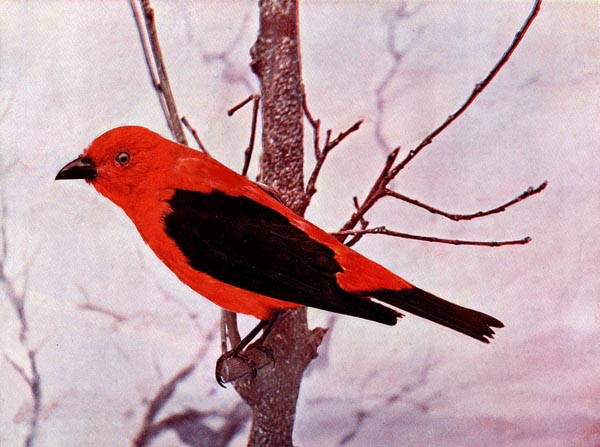
scarlet tanager.
From col. F. M. Woodruff.
[Pg 217]
THE SCARLET TANAGER.
What could be more beautiful
to see than this bird among the
green leaves of a tree? It almost
seems as though he would kindle
the dry limb upon which he
perches. This is his holiday
dress. He wears it during the
nesting season. After the young
are reared and the summer
months gone, he changes his
coat. We then find him dressed
in a dull yellowish green—the
color of his mate the whole year.
Do you remember another bird
family in which the father bird
changes his dress each spring
and autumn?
The Scarlet Tanager is a solitary
bird. He likes the deep
woods, and seeks the topmost
branches. He likes, too, the
thick evergreens. Here he sings
through the summer days. We
often pass him by for he is hidden
by the green leaves above us.
He is sometimes called our
“Bird of Paradise.”
Tanagers feed upon winged
insects, caterpillars, seeds, and
berries. To get these they do
not need to be on the ground.
For this reason it is seldom we
see them there.
Both birds work in building
the nest, and both share in caring
for the little ones. The
nest is not a very pretty one—not
pretty enough for so beautiful
a bird, I think. It is woven
so loosely that if you were standing
under it, you could see light
through it.
Notice his strong, short beak.
Now turn to the picture of the
Rose-Breasted Grosbeaks in
April Birds. Do you see how
much alike they are? They are
near relatives.
I hope that you may all have
a chance to see a Scarlet Tanager
dressed in his richest scarlet
and most jetty black.
[Pg 218]
THE RUFFED GROUSE.

HE Ruffed Grouse, which is
called Partridge in New England
and Pheasant in the
Middle and Southern States,
is the true Grouse, while Bob White
is the real Partridge. It is unfortunate
that they continue to be confounded.
The fine picture of his
grouseship, however, which we here
present should go far to make clear
the difference between them.
The range of the Ruffed Grouse is
eastern United States, south to North
Carolina, Georgia, Mississippi, and
Arkansas. They hatch in April, the
young immediately leaving the nest
with the mother. When they hear
the mother’s warning note the little
ones dive under leaves and bushes,
while she leads the pursuer off in an
opposite direction. Building the nest
and sitting upon the eggs constitute
the duties of the female, the males
during this interesting season keeping
separate, not rejoining their mates
until the young are hatched, when
they begin to roam as a family.
Like the Turkey, the Ruffed Grouse
has a habit of pluming and strutting,
and also makes the drumming noise
which has caused so much discussion.
This noise “is a hollow vibrating
sound, beginning softly and increasing
as if a small rubber ball were dropped
slowly and then rapidly bounced on a
drum.” While drumming the bird
contrives to make himself invisible,
and if seen it is difficult to get the
slightest clue to the manner in which
the sound is produced. And observers
say that it beats with its wings on a
log, that it raises its wings and strikes
their edges above its back, that it claps
them against its sides like a crowing
rooster, and that it beats the air. The
writer has seen a grouse drum, appearing
to strike its wings together over
its back. But there is much difference
of opinion on the subject, and young
observers may settle the question for
themselves. When preparing to drum
he seems fidgety and nervous and his
sides are inflated. Letting his wings
droop, he flaps them so fast that they
make one continuous humming sound.
In this peculiar way he calls his mate,
and while he is still drumming, the
hen bird may appear, coming slyly
from the leaves.
The nest is on the ground, made by
the female of dry leaves and a few
feathers plucked from her own breast.
In this slight structure she lays ten or
twelve cream-colored eggs, specked
with brown.
The eyes of the Grouse are of great
depth and softness, with deep expanding
pupils and golden brown iris.
Coming suddenly upon a young
brood squatted with their mother near
a roadside in the woods, an observer
first knew of their presence by the old
bird flying directly in his face, and
then tumbling about at his feet with
frantic signs of distress and lameness.
In the meantime the little ones scattered
in every direction and were not
to be found. As soon as the parent
was satisfied of their safety, she flew a
short distance and he soon heard her
clucking call to them to come to her
again. It was surprising how quickly
they reached her side, seeming to pop
up as from holes in the ground.
[Pg 220]
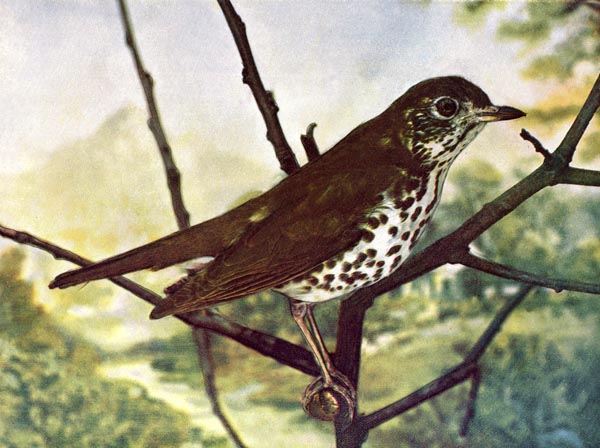
ruffed grouse.
From col. F. M. Woodruff.
[Pg 221]
THE RUFFED GROUSE.
At first sight most of you will
think this is a turkey. Well, it
does look very much like one.
He spreads his tail feathers,
puffs himself up, and struts about
like a turkey. You know by
this time what his name is and I
think you can easily see why he
is called Ruffed.
This proud bird and his mate
live with us during the whole
year. They are found usually in
grassy lands and in woods.
Here they build their rude
nest of dried grass, weeds and
the like. You will generally
find it at the foot of a tree, or
along side of an old stump in or
near swampy lands.
The Ruffed Grouse has a
queer way of calling his mate.
He stands on a log or stump,
puffed up like a turkey—just as
you see him in the picture. Then
he struts about for a time just
as you have seen a turkey gobbler
do. Soon he begins to work
his wings—slowly at first, but
faster and faster, until it sounds
like the beating of a drum.
His mate usually answers his
call by coming. They set up
housekeeping and build their
rude nest which holds from eight
to fourteen eggs. As soon as
the young are hatched they can
run about and find their own
food. So you see they are not
much bother to their parents.
When they are a week old they
can fly. The young usually stay
with their parents until next
Spring. Then they start out and
find mates for themselves.
I said at the first that the
Ruffed Grouse stay with us all
the year. In the winter, when
it is very cold, they burrow into
a snowdrift to pass the night.
During the summer they always
roost all night.
[Pg 222]
THE BLACK AND WHITE CREEPING WARBLER.

HIS sprightly little bird is met
with in various sections of the
country. It occurs in all parts
of New England and New
York, and has been found in the interior
as far north as Fort Simpson. It
is common in the Bahamas and most
of the West India Islands, generally as
a migrant; in Texas, in the Indian
Territory, in Mexico, and throughout
eastern America.
Dr. Coues states that this warbler is
a very common summer resident near
Washington, the greater number going
farther north to breed. They arrive
there during the first week in April
and are exceedingly numerous until
May.
In its habits this bird seems to be
more of a creeper than a Warbler. It
is an expert and nimble climber, and
rarely, if ever, perches on the branch
of a tree or shrub. In the manner of
the smaller Woodpecker, the Creepers,
Nuthatches, and Titmice, it moves
rapidly around the trunks and larger
limbs of the trees of the forest in search
of small insects and their larvae. It
is graceful and rapid in movement,
and is often so intent upon its hunt as
to be unmindful of the near presence
of man.
It is found chiefly in thickets, where
its food is most easily obtained, and
has been known to breed in the immediate
vicinity of a dwelling.
The song of this Warbler is sweet
and pleasing. It begins to sing from
its first appearance in May and continues
to repeat its brief refrain at
intervals almost until its departure in
August and September. At first it is
a monotonous ditty, says Nuttall,
uttered in a strong but shrill and filing
tone. These notes, as the season advances,
become more mellow and warbling.
The Warbler’s movements in search
of food are very interesting to the
observer. Keeping the feet together
they move in a succession of short,
rapid hops up the trunks of trees and
along the limbs, passing again to the
bottom by longer flights than in the
ascent. They make but short flight
from tree to tree, but are capable of
flying far when they choose.
They build on the ground. One
nest containing young about a week
old was found on the surface of shelving
rock. It was made of coarse strips
of bark, soft decayed leaves, and dry
grasses, and lined with a thin layer of
black hair. The parents fed their
young in the presence of the observer
with affectionate attention, and showed
no uneasiness, creeping head downward
about the trunks of the neighboring
trees, and carrying large smooth
caterpillars to their young.
They search the crevices in the
bark of the tree trunks and branches,
look among the undergrowth, and
hunt along the fences for bunches of
eggs, the buried larvae of the insects,
which when undisturbed, hatch out
millions of creeping, crawling, and
flying things that devastate garden
and orchard and every crop of the field.
[Pg 224]
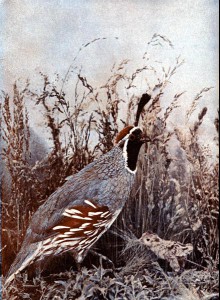
black and white creeping warbler.
From col. Chi. Acad. Sciences.
Chicago Colortype Co.
[Pg 225]
VOLUME 1. JANUARY TO JUNE, 1897.
INDEX.
| Birds, The Return of the | pages | 101 |
| Bird Song | “ | 187-8 |
| Bird Day in the Schools | “ | 129-138 |
| Birds and Farmers | “ | 213 |
| Black Bird, Red-winged, Agelaeus Phœniceus | “ | 64-68-70-71 |
| Blue Bird, Sialia Sialis | “ | 75-76-78 |
| Bobolink, Dolichonyx Gryzivorus | “ | 92-3-4 |
| Bunting, Indigo, Passerina Cyanea | “ | 172-3 |
| Catbird, Galeoscoptes Carolinensis | “ | 183-4-6 |
| Chickadee, Black-capped, Parus Atricopillus | “ | 164-5-7 |
| Cock of the Rock | “ | 19-21 |
| Crossbill, American, Loxia Curvirostra | “ | 126-7 |
| Crow, American, Corvus Americanus | “ | 97-8-100 |
| Duck, Mandarin, A. Galericulata | “ | 8-9-11 |
| Flicker, Colaptes Auratus | “ | 89-90 |
| Fly-catcher, Scissor-tailed, Milvulus Forficatus | “ | 161-3 |
| Gallinule, Purple, Ionoruis Martinica | “ | 120-1 |
| Grebe, Pied-billed, Podilymbus Podiceps | “ | 134-5-7 |
| Grosbeak, Rose-breasted, Habia Ludoviciana | “ | 113-115 |
| Grouse, Ruffed, Bonasa Umbellus | “ | 218-220-221 |
| Gull, Ring-billed, Larus Delawarensis | “ | 198-199 |
| Halo, The | “ | 150 |
| Hawk, Marsh, Circus Hudsonius | “ | 158-159 |
| Hawk, Night, Chordeiles Virginianus | “ | 175-6-8 |
| Heron, Black-crowned, Nycticorax Nycticorax Naevius | “ | 196-7 |
| Jay, American Blue, Cyanocitta Cristata | “ | 39-41 |
| Jay, Arizona Green, Xanthoura Luxuosa | “ | 146-148 |
| Jay, Canada, Perisoreus Canadensis | “ | 116-17-19 |
| Kingfisher, American, Ceryle Alcyon | “ | 60-61-63 |
| Lark, Meadow, Sturnella Magna | “ | 105-7-8 |
| Longspur, Smith’s, Calcarius PictusLongspur, Smith’s, Calcarius Pictus | “ | 123-5 |
| Lory, Blue Mountain | “ | 66-67 |
| Mocking Bird, American, Mimus Polyglottos | “ | 192-193-201 |
| Mot Mot, Mexican | “ | 49-57 |
| Nesting Time | “ | 149-150 |
| Nonpareil, Passerina Ciris | “ | 1-3-15 |
| Oriole, Baltimore, Icterus Galbula | “ | 205-6-7 |
| Oriole, Golden, Icterus Icterus | “ | 34-36 |
| Oriole, Orchard, Icterus Spurius | “ | 154-5 |
| Owl, Long-eared, Asio Wilsonianus | “ | 109-111-112 |
| Owl, Screech, Megascops Asio | “ | 151-3-7 |
| Owl, Snowy, Nyctea Nivea | “ | 209-210-211 |
| Paradise, Red Bird of, Paradisea Rubra | “ | 22-23-25 |
| Parrakeet, Australian | “ | 16-18 |
| Parrot, King | “ | 50-51 |
| Pheasant, Golden, P. Pictus | “ | 12-13 |
| Pheasant, Japan | “ | 86-88 |
| Red Bird, American, Cardinalis Cardinalis | “ | 72-74 |
| Robin, American, Merula Migratoria | “ | 53-4-5-9 |
| Roller, Swallow-tailed, Indian | “ | 42-43 |
| Shrike, Loggerhead, Lanius Ludovicianus | “ | 202-203 |
| Swallow, Barn, Chelidon Erythrogaster | “ | 79-80 |
| Tanager, Red-rumped, Tanagridæ | “ | 30-31-33 |
| Tanager, Scarlet, Piranga Erythromelas | “ | 214-216-217 |
| Tern, Black, Hydrochelidon Ingra Surinamensis | “ | 103-104 |
| Thrush, Brown, Harporhynchus Rufus | “ | 82-83-84 |
| Thrush, Wood, Turdus Mustelinus | “ | 179-180-183 |
| Toucan, Yellow-throated, Ramphastos | “ | 26-27-29 |
| Trogon, Resplendent, Trogonidæ | “ | 4-7 |
| Vireo, Yellow-throated, Vireo Flavifrons | “ | 189-191 |
| Warbler, Black-and-white Creeping, Mniotilta Varia | “ | 222-224 |
| Warbler, Prothonotary, Protonotaria Citrea | “ | 168-169-171 |
| Wax Wing, Bohemian, Ampelis Garrulus | “ | 140-141 |
| Woodpecker, California, Melanerpes Formicivorus Bairdi | “ | 130-131-133 |
| Woodpecker, Red-headed, Melanerpes Erythrocephalus | “ | 45-46-47 |
| Wren, Long-billed Marsh, Cistothorus Palustris | “ | 142-144-145 |
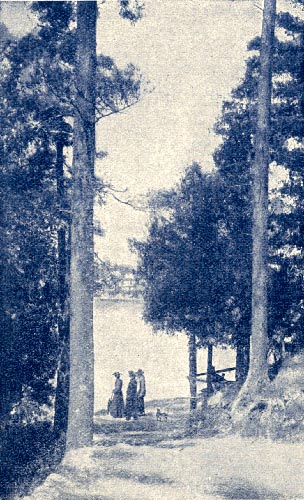
elkhart lake.
Summer Excursion
Tickets to the resorts
of Wisconsin, Minnesota,
Michigan, Colorado, California,
Montana, Washington,
Oregon, and British
Columbia; also to Alaska,
Japan, China, and all Trans-Pacific
Points, are now on
sale by the CHICAGO,
MILWAUKEE & ST.
PAUL RAILWAY. Full
and reliable information
can be had by applying to
Mr. C. N. SOUTHER,
Ticket Agent, 95 Adams
Street, Chicago.
Please mention “BIRDS” when you write to advertisers.
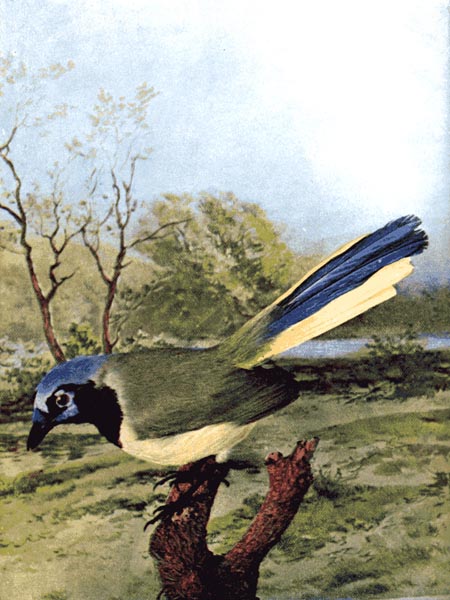
Please mention “BIRDS” when you write to advertisers.
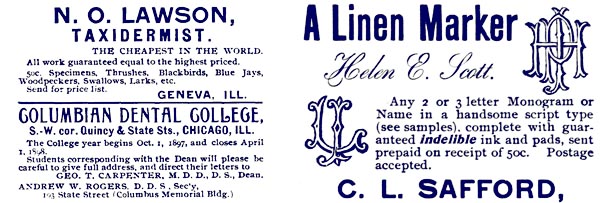
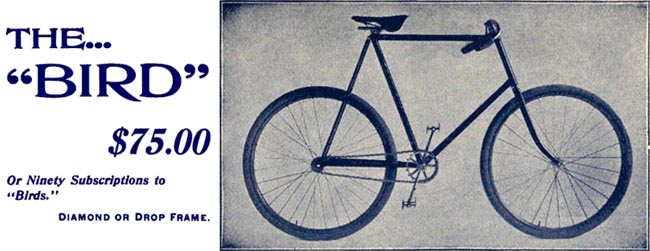
This wheel is made especially for the Nature Study Publishing Co., to be used as a premium. It is unique in
design, of material the best, of workmanship unexcelled. No other wheel on the market can compare favorably
with it for less than $100.00.
SPECIFICATIONS FOR 1897 “BIRD” BICYCLE.
Frame.—Diamond pattern; cold-drawn seamless steel tubing;
11⁄8 inch
tubing in the quadrangle with the exception of the head, which is
11⁄4inch. Height, 23, 24, 25 and 26 inches.
Rear triangle 3⁄4 inch tubing in
the lower and upright bars. Frame Parts.—Steel drop forgings,
strongly reinforced connections. Forks.—Seamless steel fork sides,
gracefully curved and mechanically reinforced. Steering Head.—9, 11
and 13 inches long, 11⁄4
inches diameter. Handle Bar.—Cold-drawn,
weldless steel tubing, 7⁄8 inch in diameter, ram’s horn, upright or
reversible, adapted to two positions. Handles.—Cork or corkaline;
black, maroon or bright tips. Wheels.—28 inch, front and rear. Wheel
Base.—43 inches. Rims.—Olds or Plymouth. Tires.—Morgan & Wright,
Vim, or Hartford. Spokes.—Swaged, Excelsior Needle Co.’s best
quality; 28 in front and 32 in rear wheel. Cranks.—Special steel,
round and tapered; 61⁄2
inch throw. Pedals.—Brandenburg; others on
order. Chain.—1⁄4 inch, solid link, with hardened rivet steel
centers. Saddle.—Black, attractive and comfortable; our own make.
Saddle Post.—Adjustable, style “T.” Tread.
—47⁄8 inches. Sprocket
Wheels.—Steel drop forgings, hardened. Gear.—68 regular; other
gears furnished if so desired. Bearings.—Made of the best selected
high-grade tool steel, carefully ground to a finish after tempering, and
thoroughly dust-proof. All cups are screwed into hubs and crank hangers.
Hubs.—Large tubular hubs, made from a solid bar of steel.
Furnishing.—Tool-bag, wrench, oiler, pump and repair kit. Tool
Bags.—In black or tan leather, as may be preferred. Handle bar, hubs,
sprocket wheels, cranks, pedals, seat post, spokes, screws, nuts and
washers, nickel plated over copper; remainder enameled. Weight.—22
and 24 pounds.
Send for Specifications for Diamond Frame.
NATURE STUDY PUBLISHING CO.
Agents Wanted in every Town and City to represent "BIRDS."
CHICAGO.
Please mention “BIRDS” when you write to advertisers.

We give below a list of publications, especially fine, to be read in
connection with our new magazine, and shall be glad to supply them at
the price indicated, or as premiums for subscriptions for “Birds.”
| “Birds Through an Opera Glass” | 75c. | or | 2 | subscriptions. | ||||
| “Bird Ways” | 60c. | “ | 2 | “ | ||||
| “In Nesting Time” | $1.25 | “ | 3 | “ | ||||
| “A Bird Lover of the West” | 1.25 | “ | 3 | “ | ||||
| “Upon the Tree Tops” | 1.25 | “ | 3 | “ | ||||
| “Wake Robin” | 1.00 | “ | 3 | “ | ||||
| “Birds in the Bush” | 1.25 | “ | 3 | “ | ||||
| “A-Birding on a Bronco” | 1.25 | “ | 3 | “ | ||||
| “Land Birds and Game Birds of New England” | 3.50 | “ | 8 | “ | ||||
| “Birds and Poets” | 1.25 | “ | 3 | “ | ||||
| “Bird Craft” | 3.00 | “ | 7 | “ | ||||
| “The Story of the Birds” | .65 | “ | 2 | “ | ||||
| “Hand Book of Birds of Eastern North America” | 3.00 | “ | 7 | “ |
See our notice on another page concerning Bicycles. Our “Bird” Wheel is
one of the best on the market—as neat and attractive as “Birds.”
We shall be glad to quote a special price for teachers or clubs.
We can furnish any article or book as premium for subscriptions for
“Birds.”
Address,
Nature Study Publishing Co. Chicago, Ill.
Nature Study Publishing Company.

HE Nature Study Publishing Company is a corporation of educators and
business men organized to furnish correct reproductions of the colors
and forms of nature to families, schools, and scientists. Having secured
the services of artists who have succeeded in photographing and
reproducing objects in their natural colors, by a process whose
principles are well known but in which many of the details are held
secret, we obtained a charter from the Secretary of State in November,
1896, and began at once the preparation of photographic color plates for
a series of pictures of birds.
The first product was the January number of “BIRDS,” a monthly magazine,
containing ten plates with descriptions in popular language, avoiding as
far as possible scientific and technical terms. Knowing the interest
children have in our work, we have included in each number a few pages
of easy text pertaining to the illustrations. These are usually set
facing the plates to heighten the pleasure of the little folks as they
read.
Casually noticed, the magazine may appear to be a children’s publication
because of the placing of this juvenile text. But such is not the case.
Those scientists who cherish with delight the famous handiwork of
Audubon are no less enthusiastic over these beautiful pictures which are
painted by the delicate and scientifically accurate fingers of Light
itself. These reproductions are true. There is no imagination in them
nor conventionalism. In the presence of their absolute truth any written
description or work of human hands shrinks into insignificance. The
scientific value of these photographs can not be estimated.
To establish a great magazine with a world-wide circulation is no light
undertaking. We have been steadily and successfully working towards that
end. Delays have been unavoidable. What was effective for the production
of a limited number of copies was inadequate as our orders increased.
The very success of the enterprise has sometimes impeded our progress.
Ten hundred teachers in Chicago paid subscriptions in ten days. Boards
of Education are subscribing in hundred lots. Improvements in the
process have been made in almost every number, and we are now assured of
a brilliant and useful future.
When “BIRDS” has won its proper place in public favor we shall be
prepared to issue a similar serial on other natural objects, and look
for an equally cordial reception for it.
PREMIUMS.
To teachers we give duplicates of all the pictures on separate sheets
for use in teaching or for decoration.
To other subscribers we give a color photograph of one of the most
gorgeous birds, the Golden Pheasant.
Subscriptions, $1.50 a year including one premium. Those wishing both
premiums may receive them and a year’s subscription for $2.00.
We have just completed an edition of 50,000 back numbers to accommodate
those who wish their subscriptions to date back to January, 1897, the
first number.
We will furnish the first volume, January to June inclusive, well bound
in cloth, postage paid, for $1.25. In Morocco, $2.25.
AGENTS.
10,000 agents are wanted to travel or solicit at home.
We have prepared a fine list of desirable premiums for clubs which any
popular adult or child can easily form. Your friends will thank you for
showing them the magazine and offering to send their money. The work of
getting subscribers among acquaintances is easy and delightful. Agents
can do well selling the bound volume. Vol. 1 is the best possible
present for a young person or for anyone specially interested in nature.
Teachers and others meeting them at institutes do well as our agents.
The magazine sells to teachers better than any other publication because
they can use the extra plates for decoration, language work, nature
study, and individual occupation.
NATURE STUDY PUBLISHING COMPANY,
277 Dearborn Street, Chicago.
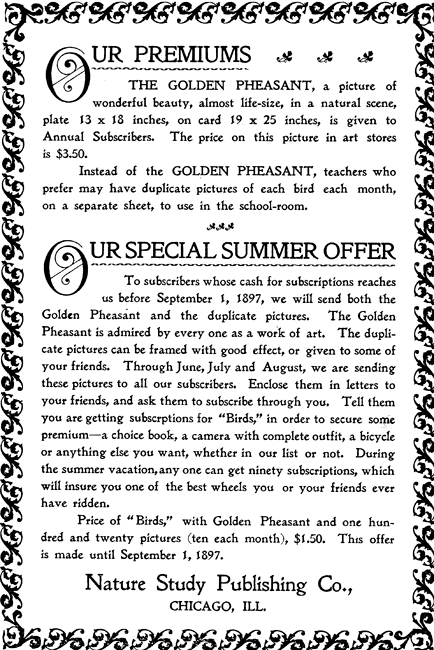
Featured Books

The Eight Strokes of the Clock
Maurice Leblanc
ed."Well, I had a great argument with my uncle and aunt last night. Theyabsolutely refuse to sign th...

The Tadpoles of Bufo cognatus Say
Hobart M. Smith
unty State Park,Kansas, and the other lacks data. The second lot contains numeroussizes of tadpoles ...

Natural History of the Bell Vireo, Vireo bellii Audubon
Jon C. Barlow
ntenance of Territory260 Aggressive Behavior of the Female264 Interspecific Relationships2...

Ayesha, the Return of She
H. Rider Haggard
alive. As it was promised in the Caves of Kôr She has returned again. To you therefo...

Forest and Frontiers; Or, Adventures Among the Indians
low my camp, and disappear over the river's bank, at afavorite drinking place. These mighty monarchs...

M. P.'s in Session: From Mr. Punch's Parliamentary Portrait Gallery
Harry Furniss
g 20][Pg 21][Pg 22][Pg 23]THE ROYAL WESTMINSTER ACADEMY.(Splendid Collection of Parliamentary Portra...

The Idiot
John Kendrick Bangs
H TO CHOOSE HIS OWN FACE""JANITORS HAVE TO BE SEEN TO""MY ELOQUENCE FLOATED UP THE AIR-SHAFT"THE IDI...

The Confessions of a Caricaturist, Vol. 1
Harry Furniss
re killed by the Jersey Eagle, you are to the worldburied. We nevur correct anything, and we nevur a...
Browse by Category
Join Our Literary Community
Subscribe to our newsletter for exclusive book recommendations, author interviews, and upcoming releases.
Comments on "Birds, Illustrated by Color Photography, Vol. 1, No. 6" :